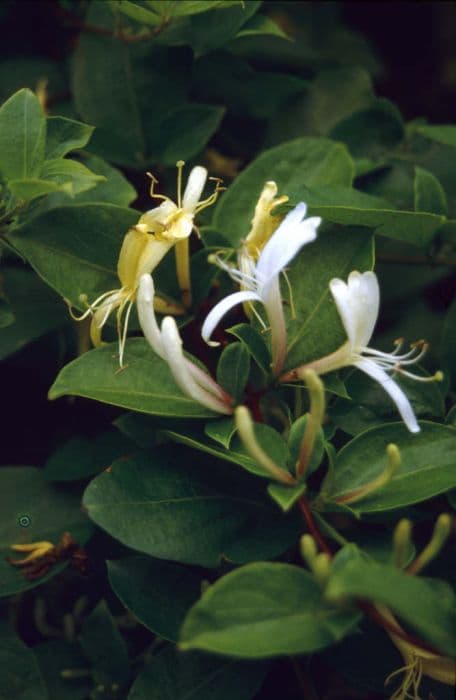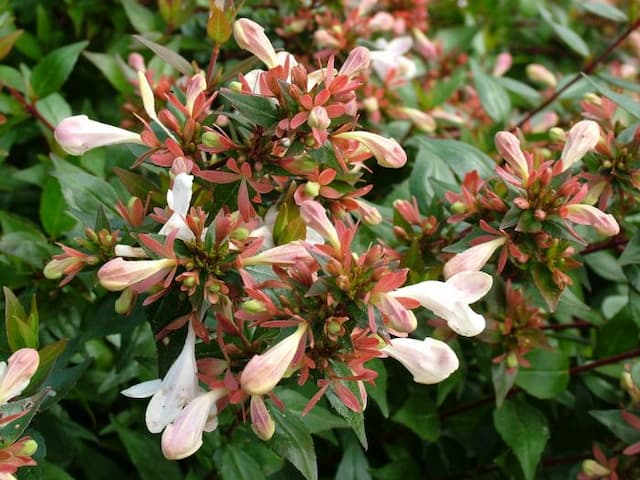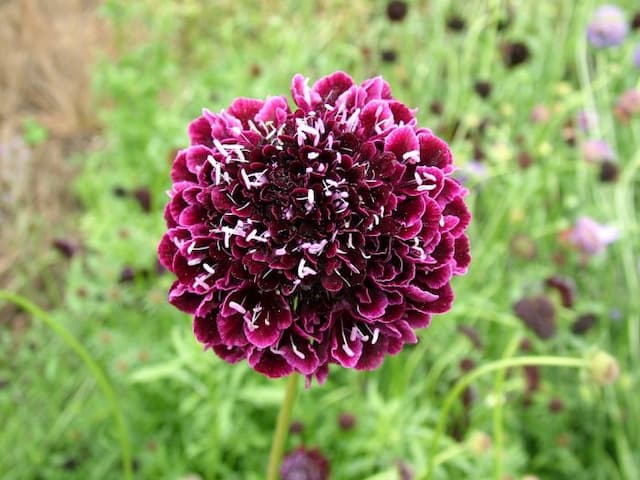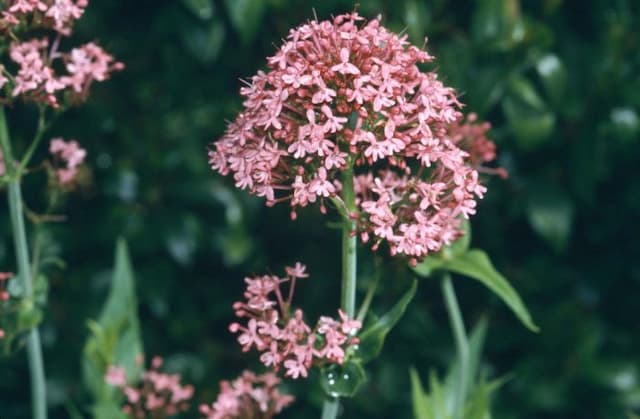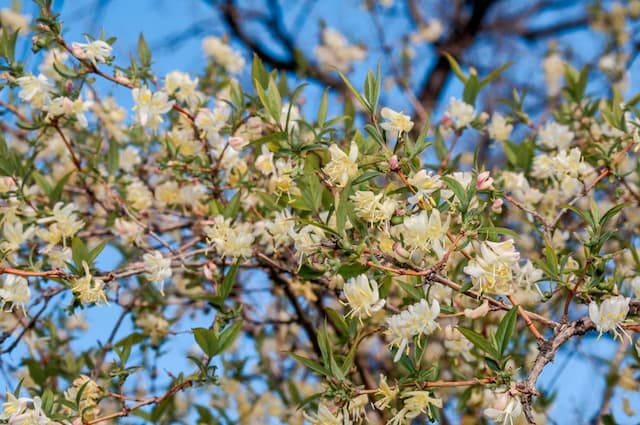Variegated Weigela Weigela florida Monet = 'Verweig' (PBR) (v)
![weigela [Monet]](/_next/image?url=https%3A%2F%2Fplants-admin.emdemapps.com%2Fimages%2Fplants%2F%2Fimages%2F604b6243e9bcd.png&w=3840&q=75)
ABOUT
Weigela florida Monet, often referred to simply as Weigela, is a decorative shrub that boasts a multitude of characteristics, making it a visually appealing addition to any garden. The plant is recognized for its compact nature and rounded form, consisting of dense, bushy foliage. Its leaves are variegated, featuring a delightful mix of colors—greens at the center blend with creamy-white edges and may include tinges of pink during cooler times of the year, offering a multi-hued tapestry that changes with the seasons. Spring and early summer witness this plant adorned with profuse blooms that are trumpet-shaped and come in a soft pink hue. The flowers are particularly attractive to bees, butterflies, and other pollinators, which adds a lively dimension to the plant's display. After the blooming season, the plant continues to shine in the garden thanks to its colorful foliage, which provides lasting interest throughout the growing season. Weigela is a deciduous shrub, meaning it will lose its leaves come autumn, revealing a somewhat less conspicuous profile of branches during the winter months. However, as the seasons turn and warmth begins to return, so too will its vibrant leaves and flowers, regenerating its full splendor year after year.
About this plant
 Names
NamesFamily
Caprifoliaceae
Synonyms
Weigela 'My Monet', Weigela florida 'Verweig', My Monet Weigela
Common names
Weigela florida Monet 'Verweig'
 Toxicity
ToxicityTo humans
Weigela is generally considered to be non-toxic to humans. Ingesting parts of this plant is not known to cause poisoning or serious health consequences. However, it is generally advisable to avoid eating ornamental plants.
To pets
Weigela is not commonly listed as a toxic plant for pets. Dogs and cats that ingest parts of the Weigela plant are unlikely to experience significant symptoms of poisoning or severe health consequences. However, it is always best to prevent pets from eating plants not intended for consumption.
 Characteristics
CharacteristicsLife cycle
Perennials
Foliage type
Deciduous
Color of leaves
Variegated
Flower color
Pink
Height
1-2 feet (30-60 cm)
Spread
1-2 feet (30-60 cm)
Plant type
Shrub
Hardiness zones
4-8
Native area
Asia
Benefits
 General Benefits
General Benefits- Attractive Foliage: Weigela florida Monet = 'Verweig' (v), commonly known as Weigela, has variegated leaves that add visual interest and color to landscapes.
- Spring Bloomer: This plant produces a profusion of pink trumpet-shaped flowers in spring, creating a vibrant display in the garden.
- Attracts Wildlife: The flowers of Weigela are a nectar source for pollinators such as bees and hummingbirds, supporting local ecosystems.
- Compact Size: Being a relatively small shrub, Weigela is suitable for gardeners with limited space, including urban settings and small yards.
- Low Maintenance: Weigela is known for being easy to care for, requiring minimal pruning and able to tolerate a range of soil conditions.
- Seasonal Interest: Weigela provides year-round interest through its foliage in spring and summer, flowers in spring, and structural form in winter.
- Hardy Plant: It is quite hardy and can survive in a range of climates and conditions, making it suitable for various landscapes.
- Border Planting: Weigela works well when planted in borders or as part of a mixed shrubbery, offering structure and variety.
- Suitable for Containers: It can also thrive in containers, making it a versatile choice for patios, balconies, and terrace gardens.
- Deer Resistance: Weigela is considered deer-resistant, making it a practical choice for areas where deer browsing is a problem.
 Medical Properties
Medical PropertiesThis plant is not used for medical purposes.
 Air-purifying Qualities
Air-purifying QualitiesThis plant is not specifically known for air purifying qualities.
 Other Uses
Other Uses- Weigela florida can be used in bonsai culture, as its attractive foliage and flowers make striking miniature trees.
- The dense growth habit of Weigela can provide hiding spots for small wildlife, such as birds and beneficial insects, within a garden.
- Dried Weigela branches can be used for decorative purposes in floral arrangements and crafts due to their interesting form.
- Weigela wood is occasionally used in small woodworking projects, like making tool handles or carved ornaments.
- The flowers can be used for hand-pollinating other plants as an educational activity to demonstrate pollination techniques.
- Weigela leaves can be used to create natural leaf mold compost, adding nutrients and structure to garden soil as they decompose.
- Due to its dense foliage, Weigela can be planted as part of a privacy screen or hedge to create secluded spaces in gardens.
- Weigela can be used in sensory gardens, as the textured leaves and fragrant flowers provide tactile and olfactory experiences.
- The plant can serve as a living fence or boundary marker, owing to its growth pattern and ability to be shaped through pruning.
- Finally, Weigela's fibrous root system can help in soil stabilization on slopes to prevent erosion.
Interesting Facts
 Feng Shui
Feng ShuiThe plant Weigela is not used in Feng Shui practice.
 Zodiac Sign Compitability
Zodiac Sign CompitabilityThe plant Weigela is not used in astrology practice.
 Plant Symbolism
Plant Symbolism- Beauty: Weigela is known for its beautiful tubular flowers that bloom prolifically in spring, symbolizing the splendor and beauty found in nature.
- Resilience: This plant is hardy and easy to grow, representing resilience and adaptability in various conditions.
- Nostalgia: Often found in traditional gardens, Weigela can evoke feelings of nostalgia and can symbolize a longing for the past or for simpler times.
- Prosperity: With its abundant blossoms, Weigela is sometimes associated with prosperity and generosity, suggesting a bountiful return in different areas of life.
- Romantic Love: The pink or red flowers of Weigela are reminiscent of romance, symbolizing love and affection between partners.
 Water
WaterThe Rainbow Weigela should be watered deeply once a week, providing it with approximately 1 gallon of water per session. During periods of drought or extreme heat, increase the frequency to twice per week. Ensure the water penetrates the soil to reach the root zone without causing waterlogging. In winter or during periods of rainfall, reduce watering to prevent root rot. Monitoring the soil moisture is crucial; if the top inch of soil is dry, it's time to water again.
 Light
LightRainbow Weigela thrives in full sun to partial shade, with at least 6 hours of direct sunlight daily. The ideal spot would be where the morning sun kickstarts the plant's day, and some afternoon shade protects it from the intense heat. Avoid deep shade locations, as this can reduce flowering and lead to leggy growth.
 Temperature
TemperatureRainbow Weigela prefers temperate climates and is hardy in USDA zones 4 through 8. It can withstand minimum winter temperatures down to -20 to -30 degrees Fahrenheit, but the ideal growing temperatures are between 65 and 75 degrees Fahrenheit during the growing season. Extreme heat above 95 degrees Fahrenheit can stress the plant, requiring additional care to maintain its health.
 Pruning
PruningPrune Rainbow Weigela immediately after its spring blooming period to encourage more flowers and maintain its shape. Remove any dead or crossed branches and up to one-third of the oldest stems to promote robust new growth. Regular pruning keeps the plant looking tidy and prevents it from becoming overgrown.
 Cleaning
CleaningAs needed
 Soil
SoilVariegated Weigela prefers well-drained, fertile soil with a pH ranging from slightly acidic to neutral. A mix consisting of loam, compost, and a small amount of sand or perlite promotes healthy growth. Mulching helps retain moisture and regulate soil temperature.
 Repotting
RepottingVariegated Weigela, being a shrub, is typically planted directly in the ground and does not require regular repotting. If grown in a container, repot every 2-3 years to refresh the soil and provide room for growth.
 Humidity & Misting
Humidity & MistingVariegated Weigela is adaptable to a range of humidity levels, preferring average to moderate humidity, which generally corresponds to outdoor ambient conditions; it does not have specific high humidity requirements.
 Suitable locations
Suitable locationsIndoor
Provide bright indirect light; keep in cooler area.
Outdoor
Plant in full sun to partial shade; mulch and water regularly.
Hardiness zone
4-8 USDA
 Life cycle
Life cycleThe life cycle of Weigela florida 'Monet' starts with germination, which occurs when its seeds are sown in fertile, well-drained soil in a location with full sun to part shade, after the last frost in spring. Following germination, the seedling stage involves establishing roots and shooting up the first sets of true leaves. As the plant enters the vegetative growth stage, it rapidly increases in size, developing a bushy habit with branches that bear brightly colored leaves and, in late spring to early summer, funnel-shaped flowers that are attractive to bees and hummingbirds. Once mature, the Weigela florida 'Monet' reaches the flowering stage annually, with the blooms often reoccurring in a less vigorous flush later in the season. After the flowering period, the plant enters a period of seed production if the flowers have been pollinated, leading to fruit development and eventual seed dispersal. Perennial in nature, this shrub completes its life cycle by entering a dormant period during the winter months, with the cycle resuming with new growth in the subsequent spring.
 Propogation
PropogationPropogation time
Spring to early summer
The Weigela florida Monet, commonly known as 'Rainbow Weigela', is typically propagated through softwood cuttings. This method involves taking cuttings from new growth that is not yet firm or woody in late spring to early summer when the plant is actively growing. Cuttings should be about 4 to 6 inches long and have a few leaves removed from the bottom half to expose nodes where roots can form. The cut end can be dipped in a rooting hormone to enhance root development before being planted in a well-draining potting mix. It's essential to keep the cuttings moist and in a warm environment with indirect sunlight until roots have established, after which they can be transplanted to their permanent location.

